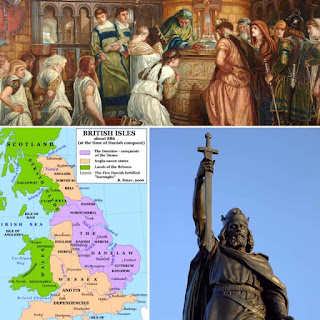The Father of England - King Alfred
The Father of England - King Alfred the Great burns some cakes and defeats the Vikings (Danes) at the Battle of Ethandun (878):
For years, the kingdom of Wessex in Britain, ruled by Alfred, had been under attack from Viking forces. Alfred had maintained a tenuous hold on his throne, but in the beginning of 878, he was forced to flee into the marshes of Somerset to hide from yet another Viking invasion. His time there marked a significant turning point in the history of England and the medieval world. Alfred could have chosen to stay in the swamp and eke out a peasant’s existence, but instead, he emerged to battle the Vikings and, in doing so, shaped the England we know today.
. . .
Alfred was a scion of the kingdom of the West Saxons, the most powerful and long-lived of the Anglo-Saxon kingdoms. But at the end of the 8th century, the Viking diaspora had suddenly changed all that, and in 878, after bearing the indignity of multiple military defeats and the deaths of all the adult males in his house, Alfred was reduced to obscuring his identity and hiding from the Vikings in the Athelney marshes of Somerset.
It is a situation that is hard for us to imagine: to be raised in a culture that was devoutly Christian but prized military prowess and lineage, to have endured the deaths of the members of his family and had the kingship thrust upon him, to have fought against Viking invaders who respected neither faith nor treaties nor oaths, and then to be forced to run or die. But Alfred possessed a mind, spirit, and a force of will that changed the course of history; and it was those winter months in 878 that were the deciding moment.
According to tradition, while in hiding, Alfred took refuge in the household of a peasant family. He did not reveal his identity but attempted to assist with daily life as a means of earning his keep and protecting his anonymity. According to the story, the family had no idea that the man helping with chores and tending the pigs was the king. One day, the housewife asked Alfred to keep an eye on cakes baking over the fire. He agreed but - preoccupied with the Viking invasions and his tenuous kingship - allowed the cakes to burn. When the housewife discovered that supper was ruined, she berated Alfred. The king of Wessex took the dressing down meekly but in that moment had a flash of inspiration that eventually led him to victory.
Like the story of George Washington chopping down the cherry tree, this story is almost certainly apocryphal, but bears an important kernel of truth. The most powerful man in Britain had been forced to run from his enemies, and to be berated by a peasant woman only added insult to injury. But even at this low point, Alfred showed humility and managed to pick himself up and keep going. In fact, he hatched a strategy that would allow him to defeat his enemies and radically change Anglo-Saxon society.
While in the Somerset marshes, Alfred plotted his counterattack. In 878, he emerged from the fens and rode out to meet several small local military forces with which he had been communicating while in hiding. The raising of these militias was a key moment toward which Alfred had been working doggedly for almost two years. His ability to command and inspire loyalty had remained intact while on the run.
It’s interesting to note that Alfred was never meant to be king; as the fifth son of a royal house, it seemed likely that he would be destined for life in the church. But the Viking invasions changed his position. With the deaths of his father and brothers, necessity born of crisis created a situation in which a hero was needed. There was no reason to expect Alfred would rise to this challenge. By this point, six of the seven kingdoms of Anglo-Saxon England had fallen to the Vikings (Danes), and the kingdom of Wessex alone maintained some degree of autonomy. It would have been largely unremarkable if Alfred had fled into the swamps and faded into oblivion while England became a Scandinavian territory.
Instead, Alfred emerged from the marshes in 878 to win the Battle of Ethandun, driving the Danes out of Wessex and pushing them back to their stronghold at Chippendum, where he eventually starved them into submission.
“He removed to Ethandun, and there fought long and fiercely in close order against all the armies of the pagans, whom with the divine help he defeated with great slaughter, and pursued them flying to their fortification. Immediately he slew all the men and carried off all the booty that he could find without the fortress which he immediately laid siege to with all his army. And when he had been there fourteen days the pagans, driven by cold, famine, fear, and last of all by despair, asked for peace.” (Bishop Asser)
The peace that was eventually brokered with the Danes addressed at least two important issues. First, the Danes were required to become Christians. This was an important first step in incorporating the Viking invaders into what would eventually become England. Second, the treaty with the Danes created, for the first time, a unified kingdom of the Anglo-Saxons. While the size of Alfred’s realm at the end of his reign fell far short of encompassing the England we know today, it was the largest unified territory ever ruled by an Anglo-Saxon leader and laid the foundation for what would become the kingdom of the English, ruled by Alfred’s grandson.
Lands to the north and east became known as the Danelaw - the region where the laws of the Danes were in effect. The existence of these two kingdoms side by side - the Danelaw and the Anglo-Saxons - had a profound effect on the English language. The Scandinavian languages spoken by the Viking raiders and the West Saxon dialect in Alfred’s realm were both Germanic languages - similar enough that a Dane and a Saxon could communicate reasonably well, but different enough to cause both sides difficulties. When these Germanic forms came in contact with one another, much of the variation and complexity got sanded down; the languages eventually simplified toward one another to make communication more effective.
. . .
After his victorious return from the marshes in 878, Alfred took advantage of the lull in fighting to implement an educational program. For Alfred, it was not that the Viking attacks had caused the decline of learning in England, but rather, the withering of the English scholarly tradition had led to social decay and made the Viking attacks possible. Alfred saw the revitalization of knowledge and learning in England as a key element in a plan of defense.
Part of Alfred’s educational program involved the translation of important texts into Old English. In this, he may have used Charlemagne as a model. What is different in Alfred’s case is that he wanted to make texts available to those who did not know Latin, “so that all the youth of free men now in England who have the means to apply themselves to it, be set to learning, while they are not useful for any other occupation, until they know how to read English writing well.”
Alfred himself translated some texts out of Latin and into Old English and commissioned other translations to be executed by scholars he actively recruited from the continent. Many scholars have noted that Alfred can be called both the father of the English nation and the father of English literature. Without Alfred’s educational and translation program, we would have very few texts from the early medieval period in Britain. The Anglo-Saxon Chronicle, created under Alfred, for example, gives us a fascinating picture of Anglo-Saxon life in this period.
. . .
In addition to his educational program and his desire to promote the church, Alfred instituted several defensive measures to protect the precarious peace he had achieved. First, he created a system of fortifications throughout his kingdom. Now called the “Burghal Hidage,” these fortifications strengthened the Saxon power base and undermined future attempts by the Vikings to invade. This series of fortresses could house substantial military forces and the local population during times of trouble; virtually impregnable, they worked well as bases from which Anglo-Saxon warriors could launch military strikes.
The second step in Alfred’s defensive plan was the creation of a standing army, which he divided into two sections - one always in the field and the other always ready to be called. Alfred also made it a priority to have as much of the military as possible mounted on horseback for greater mobility and flexibility. Had such a system been in place when Alfred was forced to flee, communication among his war leaders and movement from one place to another could have been achieved much more quickly.
The reason the Vikings had been such an effective fighting force was that they possessed the element of surprise - their ships were fast and maneuverable and could attack without warning. Aware of this, Alfred took the third step of his defensive reform, which was to create a strong presence on the waters around Britain. To the many of Alfred’s notable titles, we might add father of the English navy.
These three defensive elements effected a significant disruption from the Danes’ invasions against the newly established kingdom of the Anglo-Saxons. Raiding and looting were curtailed, and incursions were met with swift responses. In the years of peace that followed, Alfred reformed the legal system and oversaw the rebuilding of London.
. . .
Although we can’t say that Alfred created England as we know it, he certainly created the idea of it. In his writings, he spoke of the “Anglisch” and “Engylkynn” - “people of the English” - and transformed what had been separate but culturally similar communities into one entity. He championed literacy and learning and was pious but capable of dealing death on the battlefield. Alfred rebuilt his homeland and reached out to other communities on the continent, bringing a level of cosmopolitanism to Britain.
Like Charlemagne, Alfred the Great changed history through the force of his will. Crisis brought Alfred to a turning point, yet in that moment of crisis, he refused to give in, and his defiance against all odds made England.
Book Sources:
- “The Vikings: A History” by Robert Ferguson
- “Alfred the Great: The Man Who Made England” by Justin Pollard
Podcast Sources:
- “The History Express” podcast: Episode 93 - King Alfred the Great and the Anglo Saxons https://anchor.fm/thehistoryexpress/episodes/Episode-93---King-Alfred-the-Great-and-the-Anglo-Saxons---Royal-Family-Documentary-e9rc1c
- “In Our Time” podcast from BBC: Alfred and the Battle of Edington https://www.bbc.co.uk/programmes/p003k9gm
Top Picture: “King Alfred and the Dane” painting of the Danes being baptized and converting to Christianity by artist Andrew Benjamin Donaldson
Bottom Right Picture: King Alfred the Great Statue at Winchester
Map Source: https://www.quora.com/Was-Alfred-the-Great-considered-a-king-of-England



Comments
Post a Comment